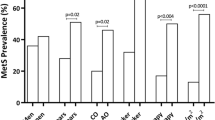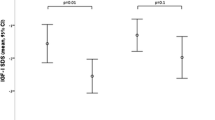Abstract
Central Diabetes Insipidus (CDI) is mainly associated with structural pathologies of the hypothalamic-pituitary area. Etiologies underlying CDI are identified in most patients, however idiopathic CDI is reported in 13–17% of cases after excluding other etiologies. The Hypopituitarism ENEA Rare Observational Study (HEROS study) retrospectively collected data of patients with idiopathic CDI from 14 pituitary centers in 9 countries. The cohort included 92 patients (59 females 64%), mean age at diagnosis was 35.4 ± 20.7 years, and a mean follow up of 19.1 ± 13.5 years following CDI diagnosis. In 6 women, diagnosis was related to pregnancy. Of 83 patients with available data on pituitary imaging, 40(48%) had normal sellar imaging, and 43(52%) had pathology of the posterior pituitary or the stalk, including loss of the bright spot, posterior pituitary atrophy or stalk enlargement. Anterior pituitary hormone deficiencies at presentation included hypogonadism in 6 (6.5%) patients (5 females), and hypocortisolism in one; during follow-up new anterior pituitary deficiencies developed in 6 patients. Replacement treatment with desmopressin was given to all patients except one, usually with an oral preparation. During follow up, no underlying disease causing CDI was identified in any patient. Patients with idiopathic CDI following investigation at baseline are stable with no specific etiology depicted during long-term follow-up.


Similar content being viewed by others
Data availability
All data is saved as an electronic sheet with the corresponding author.
References
Masri-Iraqi H, Hirsch D, Herzberg D, Lifshitz A, Tsvetov G, Benbassat C, Shimon I (2017) Central diabetes insipidus: clinical characteristics and long-term course in a large cohort of adults. Endocr Pract. https://doi.org/10.4158/EP161555.OR
Imura H, Nakao K, Shimatsu A, Ogawa Y, Sando T, Fujisawa I, Yamabe H (1993) Lymphocytic infundibuloneurohypophysitis as a cause of central diabetes insipidus. N Engl J Med 329(10):683–689
Arima H, Azuma Y, Morishita Y, Hagiwara D (2016) Central diabetes insipidus. Nagoya J Med Sci 78(4):349–357
Garrahy A, Moran C, Thompson CJ (2019) Diagnosis and management of central diabetes insipidus in adults. Clin Endocrinol 90(1):23–30
Refardt J (2020) Diagnosis and differential diagnosis of diabetes insipidus: update. Best Pract Res Clin Endocrinol Metab. https://doi.org/10.1016/j.beem.2020.101398
Masri-Iraqi H, Hirsch D, Herzberg D, Lifshitz A, Tsvetov G, Benbassat C, Shimon I (2017) Central diabetes insipidus: clinical characteristics and long-term course in a large cohort of adults. Endocr Pract 23(5):600–604
Maghnie M, Cosi G, Genovese E, Manca-Bitti ML, Cohen A, Zecca S, Tinelli C, Gallucci M, Bernasconi S, Boscherini B, Severi F, Aricò M (2000) Central diabetes insipidus in children and young adults. N Engl J Med 343(14):998–1007
Di Iorgi N, Allegri AEM, Napoli F, Calcagno A, Calandra E, Fratangeli N, Vannati M, Rossi A, Bagnasco F, Haupt R, Maghnie M (2014) Central diabetes insipidus in children and young adults: etiological diagnosis and long-term outcome of idiopathic cases. J Clin Endocrinol Metab 99(4):1264–1272
Hockaday TDR (1972) Diabetes insipidus. BMJ 2(5807):210–213
De Bellis A, Colao A, Bizzarro A, Di Salle F, Coronella C, Solimeno S, Vetrano A, Pivonello R, Pisano G, Lombardi G, Bellastella A (2002) Longitudinal study of vasopressin-cell antibodies and of hypothalamic-pituitary region on magnetic resonance imaging in patients with autoimmune and idiopathic complete central diabetes insipidus. J Clin Endocrinol Metab 87(8):3825–3829
Pivonello R, De Bellis A, Faggiano A, Di Salle F, Petretta M, Di Somma C, Perrino S, Altucci P, Bizzarro A, Bellastella A, Lombardi G, Colao A (2003) Central diabetes insipidus and autoimmunity: relationship between the occurrence of antibodies to arginine vasopressin-secreting cells and clinical, immunological, and radiological features in a large cohort of patients with central diabetes insipidus of. J Clin Endocrinol Metab 88(4):1629–1636
Maghnie M, Ghirardello S, De Bellis A, Di Iorgi N, Ambrosini L, Secco A, De Amici M, Tinelli C, Bellastella A, Lorini R (2006) Idiopathic central diabetes insipidus in children and young adults is commonly associated with vasopressin-cell antibodies and markers of autoimmunity. Clin Endocrinol 65(4):470–478
Czernichow P, Garel C, Léger J (2000) Thickened pituitary stalk on magnetic resonance imaging in children with central diabetes insipidus. In: Hormone research, vol 53. S. Karger AG, Basel, pp 61–64.
De Buyst J, Massa G, Christophe C, Tenoutasse S, Heinrichs C (2007) Clinical, hormonal and imaging findings in 27 children with central diabetes insipidus. Eur J Pediatr 166(1):43–49
Corredor Andrés B, Muñoz Calvo MT, López Pino MÁ, Márquez Rivera M, Travieso Suárez L, Pozo Román J, Argente J (2019) Thickening of the pituitary stalk in children and adolescents with central diabetes insipidus: causes and consequences. Anal Pediatr 90(5):293–300
di Iorgi N, Napoli F, Allegri AEM, Olivieri I, Bertelli E, Gallizia A, Rossi A, Maghnie M (2012) Diabetes insipidus: diagnosis and management. Horm Res Paediatr 77(2):69–84
Sherwood MC, Stanhope R, Preece MA, Grant DB (1986) Diabetes insipidus and occult intracranial tumours. Arch Dis Child 61(12):1222–1224
Mootha SL, Barkovich AJ, Grumbach MM, Edwards MS, Gitelman SE, Kaplan SL, Conte FA (1997) Idiopathic hypothalamic diabetes insipidus, pituitary stalk thickening, and the occult intracranial germinoma in children and adolescents. J Clin Endocrinol Metab 82(5):1362–1367
Charmandari E, Brook CGD (1999) 20 years of experience in idiopathic central diabetes insipidus. Lancet 353(9171):2212–2213
Liu W, Wang L, Liu M, Li G (2016) Pituitary morphology and function in 43 children with central diabetes insipidus. Int J Endocrinol. https://doi.org/10.1155/2016/6365830
Maghnie M (2003) Diabeteś insipidus. In: Hormone research, vol 59. S. Karger AG, Basel, pp 42–54
Hannon MJ, Orr C, Moran C, Behan LA, Agha A, Ball SG, Thompson CJ (2012) Anterior hypopituitarism is rare and autoimmune disease is common in adults with idiopathic central diabetes insipidus. Clin Endocrinol 76(5):725–728
Scherbaum WA, Wass JAH, Besser GM, Bottazzo GF, Doniach D (1986) Autoimmune cranial diabetes insipidus: its association with other endocrine diseases and with histiocytosis X. Clin Endocrinol 25(4):411–420
Funding
ENEA supported the production of the on-line platform for reporting the patients` data by the participating investigators.
Author information
Authors and Affiliations
Contributions
All authors contributed patients’ data and reviewed the manuscript. HMI and IS wrote the manuscript.
Corresponding author
Ethics declarations
Competing interest
The authors have no competing interests to declare.
Ethical approval
All procedures performed in studies involving human participants were in accordance with the ethical standards of the institutional research committee and with the 1964 Helsinki declaration and its later amendments or comparable ethical standards.
Informed consent
For this type of study formal consent is not required.
Additional information
Publisher’s Note
Springer Nature remains neutral with regard to jurisdictional claims in published maps and institutional affiliations.
Rights and permissions
Springer Nature or its licensor holds exclusive rights to this article under a publishing agreement with the author(s) or other rightsholder(s); author self-archiving of the accepted manuscript version of this article is solely governed by the terms of such publishing agreement and applicable law.
About this article
Cite this article
Iraqi, H.M., Pigarova, E., Zacharieva, S. et al. Idiopathic central diabetes insipidus in a large cohort of patients: the hypopituitarism ENEA rare observational (HEROS) study. Pituitary 25, 982–987 (2022). https://doi.org/10.1007/s11102-022-01277-1
Accepted:
Published:
Issue Date:
DOI: https://doi.org/10.1007/s11102-022-01277-1




